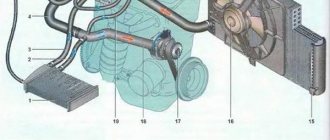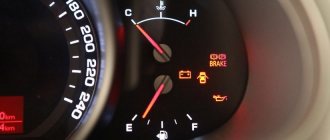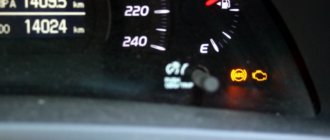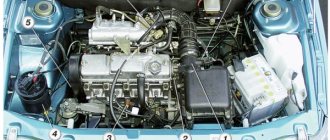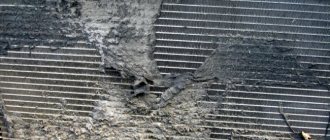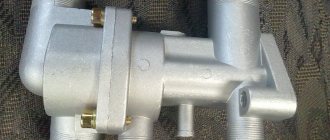An internal combustion engine is called that because the process of fuel combustion occurs inside its cylinders. In this case, a huge amount of thermal energy is released, which, thanks to the crank mechanism, is converted into mechanical energy. The temperature often exceeds 2000 degrees. No metal, no matter how strong and stable it is, can withstand such a load for long. It is precisely in order to reduce the thermal load and ensure normal temperature conditions for engine operation that the cooling system serves. If it malfunctions, the car’s power unit begins to overheat, as a result of which engine parts expand, lubricant boils, and gaskets burn out. The result of such a destructive process may be failure of the elements of the piston group and the cylinder head. To prevent such an outcome, it is important to know the possible causes of engine overheating and be prepared to eliminate them immediately.
Signs indicating that the engine is overheated
Let's consider how the VAZ-2114 power unit behaves when its operating temperature exceeds the norm. The cooling system of this car is not much different from that of other cars, except perhaps in the simplicity and unreliability of its design. So, when the engine of the “fourteenth” overheats, it lets you know about it with the following signs:
- the arrow of the coolant temperature sensor goes far into the red zone;
- The radiator cooling fan operates in constant mode;
- a specific smell appears in the cabin from boiling antifreeze (antifreeze);
- A cloud of thick, sharp-smelling steam appears from under the hood - evidence of boiling refrigerant.
How to determine if the engine is overheated
At first glance it seems very simple - according to the indicators of the engine temperature device, or - sensor. This is true, if not for one thing - novice motorists are so captivated by the road situation around them that they look at the instrument panel only in one case - how much fuel is left. Experienced motorists, on the contrary, due to their confidence in their abilities, also do not look at the car’s dashboard. And as a result, a situation often arises that overheating is detected when the engine temperature has long exceeded permissible limits, and irreparable damage has been caused to the engine. It is irreparable overheating that is one of the most complex malfunctions, which leads to very serious consequences. But more on that later. But there is a way that will not let you miss the moment of overheating. This is problematic in a traffic jam, and is not always clearly present, but here’s what you should be aware of:
— As soon as the engine temperature exceeds the permissible norm, when you sharply press the gas pedal, or when accelerating the car, even slightly, detonation knocks are clearly heard , which are popularly called “tapping fingers.” This is not true, but everyone knows this definition. If you hear such a sound, there is a 99% chance that the engine has overheated, and action must be taken.
Detonation knock is a loud metallic knock, the frequency of which coincides with the engine speed. You've probably heard such sounds when refueling with low-quality fuel. I personally don’t know where the concept of “tapping fingers” came from.
But the real reason for such knocking noises is a disruption in the fuel combustion process. What you hear is nothing more than explosions of the fuel mixture. During normal engine operation, the combustion process is controlled, but as soon as one of the operating parameters is violated, the process goes out of control and combustion turns into an explosion.
Hence the concept - detonation (from the word detonate - explode) knocks. When the engine overheats, this is the first sign.
Before continuing the conversation, let's define what is normal temperature and what is overheating. There is no one-word answer, but there are general rules. The engine temperature is within 85-95 degrees Celsius, which is working.
Engine temperature up to 100 degrees is acceptable. This means that a short-term increase in temperature to 100, sometimes up to 105 degrees is allowed. Just for a short time - up to 5 minutes.
Engine temperature above 105 degrees Celsius means overheating and action must be taken.
What to do if you overheat
If, thanks to the listed signs, you understand that your VAZ-2114 engine is heating up more than normal, follow these steps:
- turn off the engine immediately;
- roll the car closer to the side of the road (if you are on the road);
- turn on the ignition and double-check the temperature sensor readings;
- lift the hood, inspect the engine compartment to determine the location of the coolant leak;
- pay attention to the amount of antifreeze (antifreeze) in the expansion tank, but under no circumstances open it while the liquid is hot;
- try to determine the cause of overheating.
In such a situation, it is better to deliver the car to the place of repair (to a service station or garage) by towing, but if this place is located no further than 1-2 km, as a last resort, you can take a risk and get there on your own. Naturally, periodically letting the engine cool down when the sensor needle exceeds 90 degrees.
What causes overheating
There are many factors for engine overheating. In the modern world, there are only seven main ones that all car owners should always remember. This will allow you to respond in a timely manner to changes in the operation of the vehicle and its parts.
- The coolant is running out, there is too little of it in the system responsible for cooling. Antifreeze sometimes leaks out through small cracks that form in the pipes or the radiator itself. The car owner will have to regularly inspect the space under his vehicle, this will allow him to promptly identify the leak and take the necessary measures. Deposits that collect inside the system responsible for cooling contribute to jamming of the moving element of the thermostat . The device will cease to show the necessary response to the temperature indicators of the antifreeze that comes out of the engine, this will disrupt the circulation of the coolant - it will only pass through a small or large circle, this will significantly affect the proper functioning of the vehicle. If only a small circle, overheating of the engine of your vehicle is guaranteed. Large - the unit warms up too slowly, which will lead to other types of problems.
But an internal leak may occur - in this case it is much worse. Antifreeze will enter directly into the engine crankcase itself, this will help dilute the engine oil used. Water hammer is one of the expected results of such a problem, and unexpected crankshaft seizure can also occur.
Broken thermostat and other malfunctions.
Deposits that collect inside the system responsible for cooling contribute to jamming of the moving element of the thermostat itself. The device will cease to show the necessary response to the temperature indicators of the antifreeze that comes out of the engine, this will disrupt the circulation of the coolant - it will only pass through a small or large circle, this will significantly affect the proper functioning of the vehicle. If only a small circle, overheating of the engine of your vehicle is guaranteed. Large - the unit warms up too slowly, which will lead to other types of problems.
Radiator cooling is ineffective.
The dirt that collects in the space between the ribs of this unit causes such a serious problem.
Why does the engine on a VAZ-2114 get hot?
Considering that the cooling system of the “fourteenth” is quite simple, it is quite possible to bring it into working condition on your own. But first, let's look at the main reasons for engine overheating. They can be:
- insufficient amount of coolant in the system;
- the liquid pump (pump) is faulty;
- The radiator fan switch sensor has failed;
- blown fan fuse;
- the fan itself is broken;
- the radiator fins are clogged;
- The thermostat has failed;
- The expansion tank plug is faulty.
Let's look at these reasons in more detail.
Removing contaminants
In summer, various pollutants can significantly clog the radiator grille. Naturally, air cooling processes will not be as efficient. As the coolant cools in the radiator, this process also worsens.
Preventive action is cleaning the radiator. Paint that peels off honeycombs also causes this effect.
You can rinse the radiator thoroughly at a car wash. The jet from the Karcher sink should not be brought near the radiator honeycombs. Water or other water-based solutions will form scale.
When such compounds are oxidized, various impurities appear. Sand and dirt can easily cause the radiator to clog from the inside. What to do?
Flush the entire cooling system completely. As a result, we will see cloudy and dirty coolant.
Return to contents.
Insufficient coolant
Do you remember for sure that yesterday the refrigerant level was normal, but today in your VAZ-2114 the engine is heating up and the expansion tank is empty? This means that the tightness of the system was broken. And it’s good if only outside the engine. The worst thing in this case is the burnout of the cylinder head gasket. This malfunction is insidious in that liquid from the channels of the cooling jacket can get inside the cylinders, as well as into the oil channels. Because of this, the engine of the VAZ-2114 often gets hot and the car stalls. The operation of the engine is accompanied by a bluish exhaust with a characteristic odor. Here you will have to remove the cylinder head and flush the lubrication and cooling systems. In the worst case scenario, the engine will need to be overhauled.
More often, coolant leaves the system through the connections between hoses and radiator pipes (cooling and heater), thermostat, expansion tank, and engine. If the engine of a VAZ-2114 heats up and a coolant leak is obvious, check these places first! This problem is solved by tightening the clamps and adding fluid to the cooling system.
Next, inspect the hoses themselves. Often they simply crack over time, and antifreeze or antifreeze, being under pressure, flows out of the system. Such a malfunction can be eliminated by replacing one or another hose.
Reasons that can cause overheating
1. Lack of coolant. The liquid in the engine boils not because there is not enough of it, but here’s why: remember about the outer surface for cooling?
If there is a lack of fluid, the contact surface between the fluid and the heated engine is insufficient, and heat transfer to the environment is poor. This is where the overheating comes from. The engine cooling system is not sealed, as many believe, and fluid evaporates during operation - do not forget to check its level regularly.
And of course, monitor the condition of the radiator and pipes - leaks are unacceptable. There are cases of internal leakage - as a result of damage to the gasket between the head and the cylinder block. Water will not flow out of the exhaust pipe, but a constant decrease in the fluid level without visible leaks is a reason to be wary and contact a specialist.
2. Radiator condition. The gaps between the radiator honeycombs are quite small and can gradually become contaminated by representatives of the insect world.
This is not a joke; there was a case when minor contamination of the radiator (coupled with the poor condition of the engine) led to constant overheating of the car. Keep the radiator clean and blow it with compressed air at least occasionally.
3. Incorrectly set ignition angle. If the ignition angle is violated, the fuel combustion process is disrupted.
As a consequence, an increase in combustion temperature and a decrease in power. The power has dropped, but there is no need. What are we doing?
That's right - press the gas pedal harder. It turns out that more fuel is spent on the design operating mode of the engine (at which normal cooling occurs). Hence the overheating.
By the way, an ignition problem can arise (spontaneously, and not after your intervention in the finely tuned engine mechanism) if the timing belt or chain is stretched. This is not the only possibility, but it is common - keep in mind.
4. Fuel quality. An inappropriate octane number leads to a decrease in power and an increase in the temperature of fuel combustion. There is only one way out - refuel in one place, so the likelihood of getting bad gasoline is lower.
5. Deposits on the walls of the engine and radiator. The reason is simple - the use of low-quality coolant, or even water.
A little more detail. From a physics point of view, using water is better, since water has better thermal conductivity than alcohol-containing antifreeze. But - there are salts in the water (you can see them on the walls of the kettle) - the same thing happens inside the engine.
As a result, water circulation is disrupted, cooling efficiency is reduced and the engine overheats. If you are pouring water into the expansion tank, pour distilled water, it is free of salts. It is best to use special antifreeze.
Believe me, it is impossible to completely remove scale from the engine. And one more “beauty of water: if, after water, for example in winter, you fill in antifreeze - be prepared for drips (it can leak anywhere: radiator, pipes) - this is a fact. If you constantly drive “on antifreeze,” nothing will happen, but after water, antifreeze will flow 99%.
6. Engine wear. This can include many aspects, but in most cases it is wear of the piston group. During long-term use of the car, the piston rings, which serve to seal the combustion chamber, wear out, which leads to a decrease in compression, impaired fuel combustion, loss of power (remember the formula) and overheating of the car.
Somehow it turned out to be too difficult. To put it simply: fuel burns better at a certain pressure that is created in the combustion chamber. Pressure is about 12 atmospheres.
If you take a pipe, plug it with potatoes and blow inside, pressure will be created inside, which is called compression. The force with which you blow will represent the force of expansion of the fuel during combustion, which pushes on the piston and causes the crankshaft to rotate. The rings serve to fit the piston more tightly to the cylinder (in our case, potatoes and tube).
This is what happens in the engine when the piston group wears out (ring wear and cylinder wall wear). As a result, part of the expansion energy of the fuel during combustion passes by the piston (between the piston and the cylinder), and compression (optimal pressure in the combustion chamber) decreases, which worsens the quality of combustion. And again - loss of power and overheating. There is only one way out - contact a specialist.
7. Radiator fan. In some (older) car models, there was no such reason, since the fan was driven directly from the crankshaft through a belt.
Now, the fans are electric and turn on when the temperature sensor is triggered. The sensor may not work, and the fan may not turn on. This is a fairly common reason.
8. Air pockets formed when filling liquid. By the way, in this case the temperature sensor may not show an increase in temperature.
How to get rid of a traffic jam is the topic of a separate article. I’ll add on my own – when pouring liquid into the cooling system, the car must be horizontal.
9. Thermostat. The thermostat divides the cooling system into two circles - small and large.
The small one is used to warm up the car (the amount of liquid is reduced, the radiator is turned off), when a certain temperature is reached, the large circle is connected (the radiator is connected). If the thermostat is jammed, then only the small circle is used: the amount of fluid is insufficient, the radiator is turned off - the car is overheating. You can determine this by feeling the lower pipes leading to the radiator: if they are cold and the car is overheated, change the thermostat.
10. Pump. A pump is a pump that forcibly displaces water to improve circulation.
By and large, two troubles can happen to the pump: it will simply leak - you will see, and the second, which is more difficult to determine, is wear of the pump impeller. When the impeller wears out, the pump slowly pumps liquid, as a result, the liquid in the engine heats up faster than in the radiator (water circulation worsens). You can tell by uneven heating - the radiator is cold, but the engine is boiling. Attention - the same symptoms occur if the thermostat is malfunctioning or if there is an air lock.
There may also be other reasons - one of which is from the category “you can’t invent it on purpose.” For example, the parking brake is not fully weakened, which leads to the car slowing down, increasing the load on the engine, and overheating. The handbrake cable may get stuck - there was such a case. The car slows down slightly, but this is enough in the heat.
And some people also blame the air conditioner on. By and large, this is rather a far-fetched reason. Of course, the air conditioner creates additional load on the engine, but this was taken into account during the development.
If the engine is really bad - complete wear and tear - then this can happen. What to do - turn off the miracle of modern automobile manufacturing.
Perhaps we'll stop there. The only thing we'll talk about at the end is overheating in a traffic jam. No one is immune from this.
Liquid pump failure
The role of the pump in the cooling system is to create pressure through which the refrigerant circulates. Its failure can not only cause the VAZ-2114 engine to overheat, but also cause a malfunction of the gas distribution mechanism drive. The fact is that the liquid pump is driven through a gear by a timing belt. Therefore, if the pump fails, it immediately affects the performance of the entire drive. In this case, the fluid pump and possibly the timing belt will need to be replaced.
"Boiling Core"
If this is not done, the heat transfer can reach such a large volume that a so-called “boiling core” appears in the channels where the liquid is located.
A “boiling core” is a serious threat not only to the engine, but to the entire car. It is capable of reducing heat exchange processes both between hot metal and between liquids in a matter of seconds. Then the engine itself begins to heat up.
The subsequent heating process (due to the density of the coolant) can cause full boiling of the remaining “hot areas”. This is a direct path to engine failure. The pressure can increase extremely quickly, after which it is reduced by using a radiator cap.
This overheating, coupled with too much thermal stress, can cause a wide variety of problems.
For example, when a VAZ engine heats up, there is a risk that the cylinder head will be damaged. This also applies to sleeves. As a result, ignition occurs earlier than necessary. The fuel becomes less efficient. In addition, erosion appears around the sleeves and other elements.
The engine is boiling
In order to determine overheating as soon as possible, you should focus on the dashboard readings. The easiest way to do this is to carefully monitor the temperature arrow. If it starts to move rapidly towards the red zone, then you need to stop and turn on the emergency lights. After this, you should open the engine compartment and check the coolant.
Fan sensor malfunction
Failure of the fan switch sensor leads to the fact that during slow driving the radiator does not receive any forced airflow. In other words, the fan simply does not turn on and the liquid does not cool. Checking the sensor is easy. For “fourteeners” with carburetor engines, it is enough to turn on the ignition, disconnect the terminals from the sensor located on the radiator, and short them together. If the fan starts working, the sensor needs to be replaced. If the VAZ-2114 engine (8-valve injector) heats up, with the ignition on, simply remove the terminals from the coolant temperature sensor located on the right of the cylinder block. The electronic control unit will command the engine to operate in emergency mode, and the fan will have to turn on. If this happens, replace the sensor.
But there is one more nuance here - a fuse. If it burns out, the fan, of course, will not turn on. In the mounting block under the hood, find fuse F4 or F8. It is indicated by the corresponding symbol - a propeller. Remove it from the socket and check it with a tester. Replace if necessary.
What to do if your car overheats in a traffic jam
When driving a car for a long time in a lower gear, the engine operates with increased power, which in itself leads to overheating. Add to this the lack of oncoming air flow necessary to cool the radiator. What to do?
The main thing is not to panic. Short-term overheating is not terrible, but if you see that the car is not cooling down, it’s time to act.
Important - do not turn off the engine unless absolutely necessary. Exactly - without extreme. A stalled, overheated engine is an almost 100% guarantee of repair. It will take quite a long time to describe what is happening in the engine in this case (rotating the liners together with the crankshaft, when the engine is subsequently started - the least of the possible troubles), just take it on faith.
Important - do not think about pouring water on the engine or pouring cold water into the radiator. The result is the same - repair. Moreover, you can try so hard that you cannot do without replacing the block and cylinder head. Another “beauty” of cold water is microcracks inside the block. Finding and eliminating will be very, very difficult, if not impossible. The car has overheated - try to pull over to the side of the road. If it doesn’t work out, don’t panic and don’t pay attention to those around you – it’s important for you to save the engine. Stop at idle, turn the heater on full, and wait. If after 5-10 minutes the situation does not improve, turn off the engine.
It’s a good idea to open the hood; the main thing in a panic is not to forget to set the car’s parking brake. The only reason to turn off the engine right away is clouds of steam coming from under the hood. Most likely, the cooling pipe has burst, and further operation of the engine will only worsen the situation.
This is what it looks like, engine overheating, if you look closely. Now you know why the engine gets hot and how to deal with it. Author: Igor
With the arrival of warmer weather, many drivers are faced with poor performance of the VAZ cooling system when the VAZ 2114 engine gets very hot. There are quite a few reasons why the engine overheats. You need to understand the reasons and find out ways to combat overheating.
Return to contents.
Faulty thermostat
The VAZ-2114 thermostat is the main element for distributing coolant flows. It is he who regulates the direction of its movement when the engine is cold and when it is warm. The essence of the thermostat is to switch the refrigerant flow from a small to a large circle when it reaches a certain temperature. If it starts to jam, the motor will either take a very long time to warm up, or very quickly.
You can check the VAZ-2114 thermostat in the following way. Start the engine and warm it up to a temperature of 90-95 degrees. Without turning off the ignition, touch the lower radiator hose. If it is warm (hot), then everything is in order: the coolant circulates in a large circle and overheating due to the thermostat is excluded here. If the pipe is cold, get ready to replace this part.
Chronicle of events
In the initial stage of overheating, the pistons burn out, molten metal settles on the cylinder walls, friction increases even more, the engine may stall, or it may continue to work. At the same time, the oil heats up greatly and its lubricating properties are lost; as a result, the connecting rod bearings stick to the crankshaft, and some of them may turn.
Then the cylinder head becomes deformed and the valves burn out, the valve seats begin to fly out, and a ringing metallic sound of the engine appears, which may stall or may continue to run.
Such overheating can have two endings. In the first case, the piston turns out to be the strongest element, then the crankshaft breaks, but the engine may not stall. In the second case, the piston jams and breaks in two, the skirt falls into the oil pan, and the bottom remains in the cylinder. The connecting rod with the piston pin begins to hit the cylinder walls chaotically, and eventually breaks through the block - that’s the “fist of friendship”, the engine stalls.
Tank cap
Another cause of overheating may be a plug in the expansion tank. It is designed in such a way as to maintain a certain pressure in the system, which is higher than atmospheric pressure. This is necessary to ensure that the water in the antifreeze or antifreeze does not boil at 100 degrees Celsius. If the plug is faulty and does not hold the required pressure, the coolant may boil prematurely. This will not cause significant overheating of the motor, but may cause problems with the operation of the system.
Consequences of overheating
Not all drivers know the dangers of engine overheating, and often treat this phenomenon too frivolously. Meanwhile, the consequences of engine overheating can be very serious; They depend on the degree of overheating.
Mild overheating – the engine operated at elevated temperatures for a short time (no more than 10 minutes). If the driver overheats the engine, but notices in time that the sensor shows that the permissible temperature is exceeded, the consequences will be minimal. The pistons may melt a little, but this may not affect the operation of the engine. With more severe overheating, the deformation of the pistons and rings is more pronounced, black smoke comes out of the exhaust pipe due to oil entering the combustion chambers, and the engine constantly operates as if under load. In the future, overheating will recur due to increased friction between the deformed pistons and cylinder walls.
Significant overheating occurs within twenty minutes after the sensor shows an excess temperature. The consequences are more pronounced; the picture can be complemented by deformation of the block head and the formation of cracks on it, burnout of the gasket, and destruction of the inter-ring partitions on the pistons.
Severe overheating threatens to jam the pistons in the cylinders and destroy the entire power unit. The engine can show the so-called “fist of friendship” - the connecting rod breaks through the wall of the cylinder block.
Cooling radiator
You may ask, what if all the main elements of the cooling system except the fan are working properly, but on the VAZ-2114 the engine heats up when driving, because the oncoming flow of air, even at average speed, can easily replace the propeller? There can only be one reason - the cooling radiator lamellas are clogged. Dirt, dust, leaves, branches, insects - all this settles in layers day after day, not allowing air to blow through the slats.
To prevent this situation, the radiator must be periodically washed with a stream of water to remove contamination.
Consequences of overheating
For many drivers, engine overheating is a common problem that does not seriously threaten their vehicle. But due to engine overheating, the vehicle can receive very serious damage; the driver must take this factor into account:
Slight engine overheating
If the unit did not operate for so long under colossal temperature loads, nothing serious will happen. It is important that the driver timely evaluates the indicators of a special sensor indicating the presence of a problem. The pistons will melt a little, but the engine will continue to function normally. If more severe overheating occurs, the pistons are significantly deformed, and the exhaust pipe will produce exclusively black smoke. This will lead to regular repetition of overheating - deformed pistons will rub against the cylinder walls.
Serious engine overheating
The cylinder head may become deformed, the gasket may burn out, and certain elements on the pistons may collapse.
Catastrophic danger of engine overheating
Here the pistons in the cylinders can simply jam. This will lead to complete destruction of your vehicle's engine. The cylinder structural elements will be pierced by the connecting rod - you will have to transport the car to a car service center and ask for an engine replacement.
What should the temperature be?
The temperature arrow points to the red zone - overheating soon
According to the International Automotive Convention of December 1, 1992, which brought together 92 representatives of the automotive industry, it was decided to establish a uniform standard for engine temperature under operating conditions.
This indicator is 90 degrees Celsius with a maximum permissible deviation of no more than 3 degrees Celsius.
With the development of the automotive industry and a strong technological leap in the 2000s, in 2004 it was decided to revise this indicator. So, after considering all the facts and analyzing the design features of many cars, it was decided to install a floating indicator with acceptable standards beyond the border, which today is 85-105 degrees Celsius.
Operating range on the VAZ-2114
If we consider cars produced at the AvtoVAZ plant, including the VAZ-2114, the engine operating temperature range is considered to be 87-103 degrees Celsius. If we look at this problem from a functionality point of view, this is the optimal indicator.
If the temperature drops below the limit, the Samara-2 engine loses dynamics and power, and if it is higher, it can simply boil and suffer great damage. Therefore, in case of malfunctions related to the cooling system, it is necessary to eliminate them as soon as possible.
Cooling system design
Before considering cooling system malfunctions, as well as methods for eliminating them, novice motorists should study the cooling system.
So, let's look at what elements it consists of:
Cooling system design
1 — cap element of the expansion tank; 2 - expansion tank; 3 - pipe for draining liquid from the pipe; 4 — transition pipe between the radiator and the expansion tank; 5 — radiator outlet pipe; 6 — tank to the left of the radiator; 7 - aluminum tube; 8 - plugs; 9 — tank to the right of the radiator; 10 - drain plug; 11 — center of the radiator; 12 — electric fan casing; 13 — plastic wings of the electric fan; 14 - electric motor; 15 — gear pump pulley; 16 — pump impeller; 17 — camshaft drive belt; 18 — engine block; 19 — pump hose; 20 — radiator hose with power function; 21 — heater radiator hose with diverter function; 22 — coolant supply pipe to the throttle valve; 23 — outlet pipe; 24 — filling tube; 25 — heater radiator hose with power function; 26 — thermostat; 27 — coolant temperature sensor; 28 — coolant level indicator sensor.
Main malfunctions and ways to solve them
The operating temperature of the engine is directly affected by the health of the cooling system.
Almost any node can affect the change in this indicator in both directions, so it is necessary to monitor your health and prevent falls. It is temperature fluctuations that can lead to failures in other engine systems. So, let's look at the components of the cooling system, their malfunctions and solutions.
Cooling radiator
Dirty engine cooling radiator
The radiator is considered one of the most reliable parts. There are not many reasons that can lead to product failure, but this can be prevented. Debris on parts can cause the engine to overheat, but regular cleaning of the internal and external surfaces will return it to normal condition.
Cracks can cause the radiator to leak, but this problem can be fixed. There are two ways to solve the problem: weld the surface or replace the entire product. Thus, repair and restoration work normalizes the operation of the part, as well as the operating temperature in the system.
Pipes
Contamination and breakage of the SOD tube can lead to changes in engine operating temperature
Cooling system pipes can directly affect the temperature rise in the system. This is due to the fact that when cracks or delaminations form in them, it may happen that the coolant begins to leak out. In turn, the lack of “cooling” will lead to an increase in temperature, which can affect both the operation of the main power unit and increased wear.
Water pump
The water pump or pump is supposed to move coolant through the system, but if this device fails, low pressure can result in slow cooling, which in turn will cause the engine's operating temperature to rise. Often the water pump will simply leak and further movement of the car will become impossible.
It is quite simple to treat a malfunction by replacing a part.
Thermostat
Thermostat operation at different temperatures
The thermostat is the most capricious part of all available in the cooling system. Stuck product will result in improper engine temperature distribution, which in turn can increase wear on parts. So in winter it is normal that it is closed in a small circle, but in summer this can lead to malfunctions in the form of overheating, since the radiator fan does not always cope with this task. The fan will run without turning off.
Therefore, it is recommended that if the thermostat fails, replace it with a new one as soon as possible.
Radiator cooling fan
A fan is an electrical component of the cooling system that additionally and forcibly cools the fluid to operating temperature. Therefore, its main task is to prevent the engine from overheating. However, if the unit is faulty, especially when paired with the thermostat, the engine will boil up to 100% and can even cause the other main units to fail. Therefore, if a disk fails, the cause must be immediately found and corrected. Some owners are replacing the factory thermostat with a Grant model!
Methods for checking DTOZH
How to check the TOZH index yourself? To do this, you can use one of several methods; Diagnostics is carried out using a multimeter.
- First, the negative tester probe must be connected to the cylinder head, and then turn on the ignition by turning the key in the lock.
- So, using a multimeter you need to determine exactly what voltage appears at the output.
- If the controller is working properly, the value of this parameter should be at least 12 volts, of course, if the battery is fully charged. If the diagnostics showed that the obtained values were lower, then it is necessary to repair or replace the regulator (the author of the diagnostic video is the technical and mechanical channel).
What does an increase or decrease in this indicator lead to?
If the temperature drops below this norm, the engine loses power and dynamics. This will make it harder for the car to gain speed and consume more fuel. Especially often, a decrease in normal performance occurs in winter if the power plant is not warmed up enough or if the stove does not work properly. It is important to maintain the engine regularly to avoid this situation.
In summer, it is more dangerous to leave the operating temperature range, especially if the engine overheats, which happens very often at this time of year.
An increase in temperature causes fluids in the engine to boil, causing irreparable damage.
The main problem with the engine reaching operating temperatures is related to changes in the properties of the oil:
- as it decreases, it becomes more viscous;
- with increasing fluid.
This may result in under or over lubrication of parts. It is much more dangerous if the oil becomes more liquid and loses its properties, since in this case friction occurs between the iron parts, leading to their wear.
Antifreeze level VAZ 2114
Pipes VAZ 2114
Chronicle of events
First, the pistons burn out, which affects the operation of the cylinders. The crankshaft gets damaged and certain elements stick to it.
In the future, the cylinder head is susceptible to impact, this can significantly affect the functioning of the engine of your vehicle.
If the pistons are strong, the crankshaft will break, the unit can continue to operate. A seized piston breaks, it causes a lot of damage to the engine, the piston pin and connecting rod damage the cylinder - your vehicle becomes unusable.
The main reasons for tripling
If you say that your engine is not working, many will answer: the cylinder is not working. But this argument is not entirely correct, since the cylinder stops working normally. However, there may be several reasons for this:
- The valves are not suitable due to a long lack of adjustment;
- The ignition coil is faulty;
- The injectors are dirty or overfilled and must be replaced;
- The oxygen sensor stopped working;
- The air filter is broken or dirty.
- Broken ECU (electronic control unit);
- Compression in cylinders is too low;
- The spark plug is faulty or partially does not perform its function;
- The timing belt has come off or some links have simply slipped off;
- The high-voltage spark plug wire is damaged;
- DPKV (crankshaft position sensor) does not work);
What not to do when the engine is boiling
There are a number of strict rules that limit the driver’s actions during a situation when antifreeze boils in the radiator, expansion tank or other element of the cooling system. These rules are designed to protect human health from causing serious injury, and to minimize material losses that may arise in the described situation.
- Do not load the engine (do not accelerate, but instead you need to reduce the speed to idle as much as possible, usually around 1000 rpm).
- Do not stop abruptly and turn off the engine, thinking that the engine will stop boiling; on the contrary, everything will only get worse.
- Do not touch hot parts in the engine compartment!
- While steam is coming from under the cap of the expansion tank or other unit and while the antifreeze is bubbling in the system, you should absolutely not open the cap of the expansion tank! This can only be done after the time specified above has passed.
- Do not pour cold water on the engine! You need to wait for the engine to cool down on its own.
- After the engine has cooled down and new antifreeze has been added, you should not drive after the temperature reaches more than +90 degrees.
Compliance with these simple rules will ensure the safety of the driver, and also minimize the degree of breakdown and, consequently, possible material costs.


